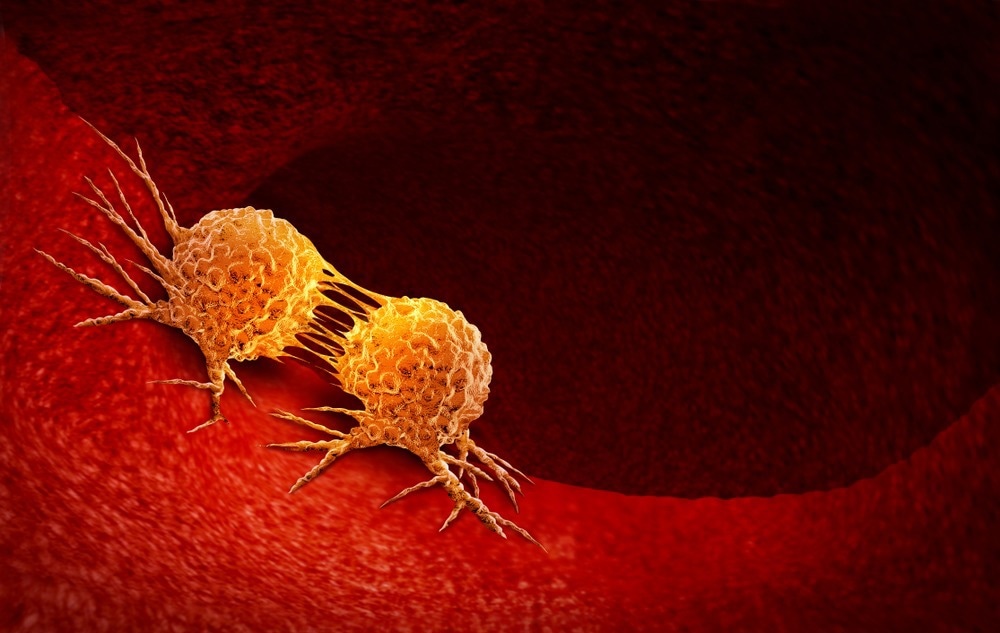Scientists have continued to improve tumor treatments like starvation therapy, photodynamic therapy (PDT), and immune therapy and are focussed on developing new therapies to change the current global cancer scenario.

Study: Drug-Induced Self-Assembly Cascade Nanoreactor for Synergistic Tumor Therapy. Image Credit: V/Shutterstock.com
In a recent Applied Materials and Interfaces study, a nano-based cancer-targeted cascade bioreactor was developed by inserting catalase (CAT), chlorin e6 (Ce6), and glucose oxidase (GOx) into human serum albumin (HSA) self-assembly molecules, for synergistic starvation and photodynamic therapy (PDT).
Bottlenecks of Conventional Cancer Therapies and Improvement Measures
One of the key limitations of conventional starvation strategies for cancer treatments is the inability to target tumor cells, which adversely affects healthy cells. Although PDT, which is based on the oxidation process of reactive oxygen species (ROS), is a powerful non-invasive approach for cancer treatment, it has several limitations that hamper its efficacy.
Some of the shortcomings of PDT that reduce its therapeutic efficacy include oxygen dependence, premature leakage tendencies, and inefficient photosensitizer loading capacity. Hence, developing new therapeutic strategies to improve cancer treatments is important.
Unfavorable conditions for conventional cancer treatments, such as acidic microenvironment and hypoxia, could be improved by catalytic reactions, which can enhance the therapeutic effectiveness. Catalytic therapy is associated with using non-toxic endogenous substances, which can effectively inhibit cancer cells.
Although several catalytic therapies, including nanozyme catalysis, chemodynamic therapy (CDT), and natural enzymes-based therapy, are used for tumor therapy, these therapies by themselves have reduced efficacy. Instead, combining catalytic therapy with various cascade reactors has been seen to improve therapeutic outcomes.
Rational integration of nanomaterials has substantially improved the therapeutic efficacy. For instance, silicon nanomaterials and hydrogel are used in cascade reactors as drug carriers. However, some of the nanoparticles used for cascade therapy are not biocompatible. Hence, there is a need for a novel biocompatible tumor suppressor that can be developed by combining effective treatments through simple methods.
In the past, natural enzymes (GOx and CAT) were infused to develop effective catalytic therapy for cancer. Nevertheless, poor stability and ineffective cell permeability have limited their therapeutic application.
Development of Nanocascade Reactors for Synergistic Tumor Therapy
Recently, scientists have constructed cancer-targeted cascade bioreactors that amplified PDT and starvation therapy based on a drug-induced self-assembly method. In this regard, GOx and CAT were incorporated into HSA to obtain HSA-GOx and HSA-CAT. These compounds were infused via paclitaxel (PTX) to ultimately form the HSA-GOx-CAT-PTX (hGCP) core structure. PTX is a chemotherapeutic drug that is hydrophobic and effectively interacts with the hydrophobic domains on HAS. The size of hGCP was around 106 nm and was spherical in shape.
HSA-chlorin e6 (Ce6) was formed via PTX inducement, whose size was around 235 nm. HSA- Ce6 was coated on hGCP to develop a shell structure HSA-GOxCAT-PTX@Ce6 (hGCP@Ce6) to protect GOx and CAT. Following this step, AS1411 aptamer was introduced on the surface of the shell structure to target tumor cells. Subsequently, a cascade reactor HSA-GOx-CAT-PTX@Ce6@AS1411 (hGCP@Ce6@ AS1411) was developed, which was almost spherical in shape.
The Role of hGCP@Ce6@ AS1411 in Tumor Therapy
The in vitro nucleolin-binding capacity of hGCP@ Ce6@AS1411 was determined using a flow cytometer and the laser scanning confocal microscope (CLSM). In this context, the self-assembled protein nanoparticles of hGCP@ Ce6@AS1411 were incubated with A549 and 4T1 cells and were studied under CLSM.
The FAM fluorescence intensity was detected on 4T1 cancer cells and A549 cancer cells that were cultured with hGCP@Ce6@AS1411. This finding indicates the efficacy of hGCP@Ce6@AS1411 in targeting nucleolin-overexpressing 4T1 cancer cells as well as human lung cancer A549 cells.
In the control L02 cells, no FAM fluorescence was observed that indicated hGCP@ Ce6@AS1411 nanomaterials did not target normal human cells. Additionally, lower toxicity and minimal side effects of hGCP@ Ce6@AS1411 were demonstrated.
The cascade reaction of hGCP@Ce6@ AS1411 included glucose decomposition, CAT catalysis, and PDT. Glucose plays an important role in the acceleration of cancer cell proliferation. Hence, starvation therapy can be implemented by restricting intracellular glucose through GOx.
The main function of GOx was to consume oxygen and glucose to produce gluconic acid and hydrogen peroxide (H2O2). CAT decomposed this newly generated H2O2 and endogenous H2O2 to release oxygen (O2). This process accelerated the glucose catalysis as well as improved the generation of 1O2 under laser irradiation. The efficacy of chemotherapy was substantially elevated by controlled release of PTX. The presence of aptamer improved therapeutic efficiency.
To determine the therapeutic effect of hGCP@Ce6@ AS1411 for supporting tumor therapies, 4T1 cells were exposed to a laser at 650 nm for 10 minutes. After illumination, the nanoparticles exhibited an excellent cancer cell-killing effect. This study recommended that hGCP@ Ce6@AS1411 with illumination had the strongest cancer cell-killing ability. This finding was validated via in vivo experiments using the 4T1 tumor-bearing mouse model.
Reference
Wang, W. et al. (2022) Drug-Induced Self-Assembly Cascade Nanoreactor for Synergistic Tumor Therapy. Applied Materials and Interfaces. https://doi.org/10.1021/acsami.2c09947
Disclaimer: The views expressed here are those of the author expressed in their private capacity and do not necessarily represent the views of AZoM.com Limited T/A AZoNetwork the owner and operator of this website. This disclaimer forms part of the Terms and conditions of use of this website.